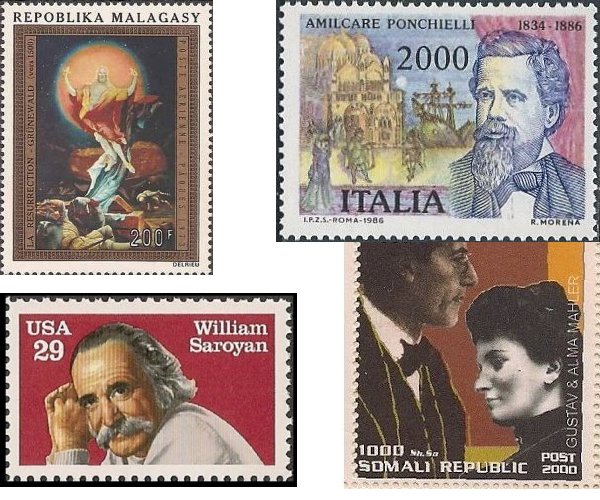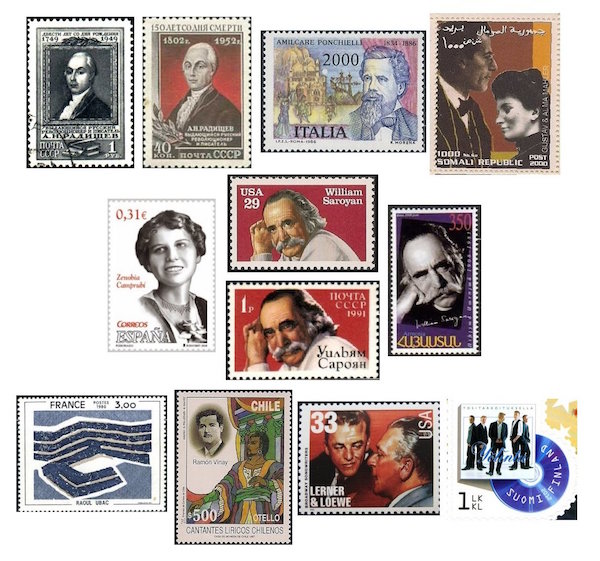The Arts on Stamps of the World — August 31
An Arts Fuse regular feature: the arts on stamps of the world.

By Doug Briscoe
On this day in the year 1287, Konrad von Würzburg, described by Wikipedia as “the chief German poet of the second half of the 13th century”, breathed his last. Little is known of his life, and there is no stamp for him, but I thought we’d remember him today with a stamp depicting his contemporary the minnesinger Hartmann von Starkenberg (fl.1260-76), because the illustration comes from the early 14th-century Codex Manesse, which also supplies us with this portrait of Konrad. He wrote two lengthy epic poems, The Trojan War (Der trojanische Krieg, unfinished despite its more than 40,000 verses) and Partenopier und Meliur, in addition to shorter verses that are seen to contain his strongest work.
About two hundred years later (c1470?) the great German religious painter Matthias Grünewald was born, and he also died on a 31st of August, in his case in the year 1528. Although recognized as one of the masters, only ten of his works, some in multiple panels, plus about 35 drawings, survive. All of these are religious pictures. His Mainz altarpiece was lost during the Thirty Years War, when the Swedes claimed it as war booty and had it shipped back home. Alas, the ship went to the bottom of the Baltic and the altarpiece with it. Grünewald served the Archbishop of Mainz as court painter in 1511 and moved on to Frankfurt the next year, where he married a converted Jew, though the young woman had to be institutionalized for some form of mental illness in 1523. Let’s begin, image-wise, with Grünewald’s masterpiece, the Isenheim Altarpiece. He worked on this from 1512 to about 1515, and it is approachable in three forms. With the wings closed, one sees a Crucifixion as the centerpiece (cf. the stamps of Cameroun and Dominica), with an Entombment (first Malagasy stamp) on the predella. With the outer wings opened, a concert of angels and nativity are revealed, with an Annunciation (Palau stamp) on the left panel and a Resurrection (second Malagasy stamp) at right. Finally, when the inner doors are opened, statuary by Niclaus of Haguenau can be seen at center with Grünewald’s paintings of Saint Anthony on either side (see upper left section of Côte d’Ivoire souvenir sheet). At the right side of the Ivoirean sheet—and on the Benin stamp juxtaposed to it—we see The Stuppach Madonna (1517-19). The largest stamp on the sheet shows Christ Bearing the Cross (from the Tauberbischofsheim altarpiece, 1523-25). The last stamp, from Burundi, offers another Crucifixion (c1515) that was probably once part of a diptych. Two important later works of art owe their existence to the Grünewald story: Paul Hindemith’s 1938 opera Mathis der Maler; and W.G. Sebald’s book-length prose-poem After Nature (1988).

Another two centuries pass before we arrive at the birth of ill-fated Russian writer Alexander Radishchev (31 August [O.S. 20 August] 1749 – 24 September [O.S. 12 September] 1802). He came of a wealthy family of Tatar descent and served as a page at the court of Catherine the Great. He studied in the West, at Leipzig, and brought ideas of the Enlightenment when he returned. Well, Catherine wasn’t having any of that. When she read his socio-economic treatise A Journey from St. Petersburg to Moscow (1790), she ordered all copies confiscated and destroyed and Radischev arrested. At first condemned to death, he had his sentence commuted to Siberian exile. It was two years before he arrived at the town of Ilimsk in 1792. Recalled by Catherine’s successor Paul in 1796, Radishchev briefly served in government revising the law code, but committed suicide with poison at 53. A Journey from St. Petersburg to Moscow was suppressed until finally being published in 1905. His bicentenary was recognized by the appreciative Soviets in 1949, and another Radischev stamp was issued just four years later, but since then, nothing.
Just as Umberto Giordano (see last Monday’s entry) is mainly known today for a single work, so it is with Amilcare Ponchielli (1834 – 16 January 1886), whose chef d’oeuvre is La Gioconda. People who aren’t familiar with opera may not know that the tune used by Allan Sherman for his comic song “Hello muddah, hello faddah” was taken from the instrumental Dance of the Hours (theme at 2:02) from La Gioconda. The Dance also contains another very famous section (beginning at 7:42) that sounds almost like a Johann Strauss fast polka. All this and “Cielo e mar” (Act II, scene iv). Ponchielli studied with his village organist father and was educated at the Milan Conservatory through the generosity of a benefactor. Besides his operas, Ponchielli wrote many ballets (these are mostly lost), much sacred music, and about 100 works for wind band (he was a municipal bandmaster at Piacenza and Cremona for about twelve years).
What an extraordinarily captivating person Alma Schindler (1879 – 11 December 1964) must have been! Not only was she married to Gustav Mahler, but after his death she wed the renowned Bauhaus architect Walter Gropius and then the prominent novelist Franz Werfel, and she had also been romantically involved with Alexander von Zemlinsky and Gustav Klimt! Her efforts as a composer were discouraged by Mahler, and she is known to have written only some 17 songs. Despite her accomplishments and fame, the only stamp of her I can find does not honor her alone but pairs her with her (first) husband.
Spanish-born writer Zenobia Camprubí Aymar (31 August 1887 – 25 October 1956) was a poet who also extensively translated the works of Rabindranath Tagore. Her brother José was owner and publisher of New York’s Spanish-language daily La Prensa from 1918 to 1942, and her husband Juan Ramón Jiménez won the Nobel Prize in Literature in 1956. Camprubí was born in Barcelona to a well-to-do family and in her childhood traveled to and studied in the United States and Switzerland. Her first story was published in a New York youth magazine when she was only 14. She settled outside New York City and started at Columbia, but returned to Spain in 1909. There she continued to publish articles in American periodicals. She founded a charitable organization in Madrid in 1918, but fled back to the US on the outset of the Spanish Civil War. Camprubí became a professor at the University of Maryland and also worked with the University of Puerto Rico, but had an operation for cervical cancer at Massachusetts General Hospital in 1951. She obtained dual Spanish-American citizenship the next year. She died in Puerto Rico just three days after Jiménez received the Nobel Prize.

American writer William Saroyan (August 31, 1908 – May 18, 1981) is up next. His father had come to New York from Armenia three years before Saroyan’s birth and lived for only three years afterward. Saroyan and his two siblings were placed in an orphanage in Oakland, California. He wrote about the experiences of Armenian immigrants in that state in his 1940 bestseller My Name is Aram. In that year he was awarded the Pulitzer Prize for Drama for The Time of Your Life (1939), which was made into a movie with James Cagney in 1948. Saroyan turned down the Pulitzer, however, but did accept the New York Drama Critics’ Circle award. In the meanwhile he won the 1943 Academy Award for Best Story for the film adaptation of his novel The Human Comedy. In that same year, by the way, he married actress Carol Marcus, who was later married to Walter Matthau. Besides novels, plays, and stories, Saroyan famously wrote journalistic pieces on great artists he had met, notably George Bernard Shaw, Jean Sibelius, and Charlie Chaplin. Speaking of music, the late American composer Jack Beeson wrote two operas based on Saroyan’s writings. The brilliant British actor and man of letters Stephen Fry (who just had a birthday on the 24th inst.) regards Saroyan very highly indeed, placing him “alongside Hemingway, Steinbeck, and Faulkner.” From 1958, Saroyan lived mostly in Paris. His ashes were divided between California and Armenia. In 1991, in the spirit of glasnost, the United States and Russia put out a joint issue honoring Saroyan.The Armenian stamp was issued for the centenary of his birth.
French artist Raoul Ubac (31 August 1910 – 24 March 1985) was born in Cologne as Rolf Ubach and grew up there and in Frankfurt before the family relocated to Malmédy in 1919. He went to Paris in 1928 and for the next few years wandered in Europe on foot. He studied literature at the Sorbonne and art at the Art Academy of Montparnasse, turning ultimately to painting, sculpture, photography, and engraving. Influenced by the Surrealists, he concentrated on photography between 1934 and 1942. He painted a number of abstracts quite similar to the one shown on the French stamp of 1980.
Ramón Vinay (1911 – January 4, 1996) was a much admired Chilean tenor remembered for his portrayals of Verdi’s Otello. He began and ended his career as a baritone; as such, he is probably the only significant opera singer to have taken on the roles of both Otello and Iago. He was also an eminent Wagnerian.
Next year will be the centenary of American lyricist Alan Jay Lerner (August 31, 1918 – June 14, 1986). Of course, his most celebrated collaboration was with Frederick Loewe, but he worked with Lorenz Hart, Kurt Weill (Love Life, 1948), Burton Lane (On a Clear Day You Can See Forever, 1965), and Leonard Bernstein (1600 Pennsylvania Avenue, 1976). He had gone to Harvard with Bernstein—they had worked on a satirical revue together—as well as with John F. Kennedy, with whom he worked on the yearbook. It was also at Harvard that Lerner lost the sight of his left eye from a boxing bout. Lerner and Loewe’s first hit was Brigadoon (1947), they had a split while working on Camelot in 1960, and reconciled to collaborate again on Gigi and The Little Prince. Lerner won three Academy Awards (Best Original Screenplay for An American in Paris, 1951, and Best Adapted Screenplay and Best Original Song for Gigi, 1958) and three Tonys (two for Gigi and one for My Fair Lady), and he was married eight times.
Ever hear of the Finnish band Yölintu? I don’t know whether they are at all well known in this country, but they have a stamp, and today is the birthday of their co-founder Simo Silmu (born 31 August 1977), so here we are. Yölintu is Finnish for “night bird”. The band was formed by Silmu and Markus Kuusijoensuu in 1992.
A graduate of the University of Massachusetts with a B.A. in English, Doug Briscoe worked in Boston classical music radio, at WCRB, WGBH, and WBUR, for about 25 years, beginning in 1977. He has the curious distinction of having succeeded Robert J. Lurtsema twice, first as host of WGBH’s weekday morning classical music program in 1993, then as host of the weekend program when Robert J.’s health failed in 2000. Doug also wrote liner notes for several of the late Gunther Schuller’s GM Recordings releases as well as program notes for the Boston Classical Orchestra. For the past few years he’s been posting a Facebook “blog” of classical music on stamps of the world, which has now been expanded to encompass all the arts for The Arts Fuse.
